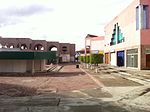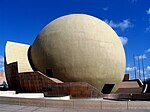United States Custom House (San Ysidro, California)
Buildings and structures completed in 1933Buildings and structures in San DiegoCustom houses in the United StatesCustom houses on the National Register of Historic PlacesGovernment buildings on the National Register of Historic Places in California ... and 3 more
Mission Revival architecture in CaliforniaNational Register of Historic Places in San DiegoWikipedia page with obscure subdivision

The United States Custom House (also known as the Old Customs House) in San Ysidro, San Diego, California, is a 1933 Spanish Revival building located 50 feet (15 m) north of the Mexico–United States border at the San Ysidro Port of Entry. It is listed on the National Register of Historic Places with the full historic name U.S. Inspection Station/U.S. Custom House and common name U.S. Custom House.
Excerpt from the Wikipedia article United States Custom House (San Ysidro, California) (License: CC BY-SA 3.0, Authors, Images).United States Custom House (San Ysidro, California)
A Mexico/To Mexico, San Diego San Ysidro
Geographical coordinates (GPS) Address Nearby Places Show on map
Geographical coordinates (GPS)
| Latitude | Longitude |
|---|---|
| N 32.5428 ° | E -117.028 ° |
Address
A Mexico/To Mexico
92173 San Diego, San Ysidro
California, United States
Open on Google Maps









